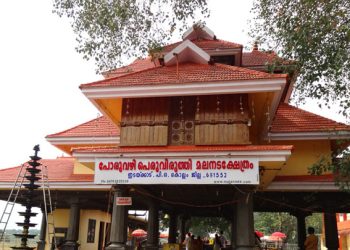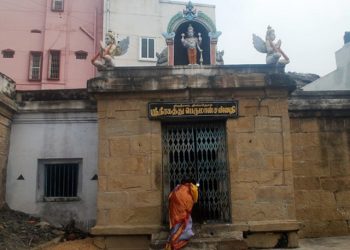Shrinathji Temple is a Hindu temple dedicated to Shrinathji in Nathdwara.It is considered an important pilgrimage centre by Vaishnavas.
Shrine’s History
The Swarup or divine form of Shrinathji is said to be self-manifested. The idol of Lord Krishna was moved during the late 17th century to what is now known as Nathdwara, Rajasthan from Govardhan during a time of social and economic upheaval in the region. When the idol reached the spot at village Sihad or Sinhad, the wheels of bullock cart in which the idol was being transported sank axle-deep in mud and could not be moved any farther. The accompanying priests realised that the particular place was the Lord’s chosen spot and accordingly, a temple was built there under the rule and protection of the then Maharana Raj Singh of Mewar. Shrinathji Temple is also known as ‘Haveli of Shrinathji . The temple was built by Goswami priests in 1672.

Legends Associated with This Shrine
According to the hagiography of the Pushtimarg, Shrinathji used to travel to Mewar to play chaupar with a Princess by the name of Ajab Kunvari. She was upset whenever her beloved Shrinathji would go back to Vraj and asked him to stay with her in the palace. Lord Shrinathji said that one day when the time was right, he would re-locate to Rajasthan. Presently, Shrinathji’s worship is performed by direct male descendants of Vallabhacharya in a haveli in Nathdwara, Rajasthan. Economy and livelihoods in Nathdwara town revolve around the Haveli, the term used for the temple probably because it was situated in a fortified mansion, or Haveli, once a royal palace of the Sesodia Rajput rulers of Mewar.
Shrinathji was quite popular with other medieval devotees, as well, as there were preachers who founded Shrinathji temples in present-day Pakistan . This was done by Shri Lalji Maharaj and his deity of Shri Gopinathji and Shri Dauji of Dera Ghazi Khan, earlier a part of undivided India and not far from here. Shrinathji has even worshipped as far away as Russia and other places on the Central Asian trade routes. Tradition holds that Shrinathji would return to Govardhan some day with a new temple at Puchri in Govardhan.

Architectural Relevance of This Shrine
The temple has been designed in the lines of the temple of Nanda Maharaj , in Vrindavan. Therefore, it is also known as Nanda Bhavan or Nandalaya . Structurally, a kalasha on the shikhara marks the top of the temple, on which seven flags are flown along with the Sudarshana Chakra. The seven flags represent the 7 ‘houses’ of Pushti Marg or Vallabh Sampradaya. The temple is also popularly called Shrinathji ki Haveli . With the mood of worship in Pushti Marg, Shrinathji is not seen as an impersonal God so the worship is not done like in a temple.
Shrinathji is seen as Thakorji or Lord of the House or Haveli and Sewa are offered rather than worship. Like a regular household it has a chariot for movement , a store room for milk , a store room for betel , a store room for sugar and sweetmeats , a store room for flowers , a functional kitchen , a jewellery chamber , a treasury , a stable for horses of chariot , a drawing room , a gold and silver grinding wheel . The Nathdwara temple has subsidiary temples dedicated to deity Madan Mohan and Naveet Priya, located in the main complex.

Shrine’s Map Location and How to Go There
By Road
Udaipur is well connected by road to major cities in India. Brilliant road network ensures people to enjoy a relaxed journey to and from Udaipur. This mode of commuting is quite easy and economical. Udaipur Bus Stand has regular bus services, connecting Udaipur with nearby cities including Delhi, Jaipur, Chittorgarh, Indore, Kota, Ajmer, Ahmedabad and Mt. Abu. Rajasthan Roadways provides the facility of Deluxe Buses and AC coaches for the convenience of passengers. One can also hire taxis and cars to reach Udaipur by road.
By Rail
The Nearest railway station is Udaipur.
By Air
Udaipur Airport namely Maharana Pratap Airport is located near Dabok at a distance of 22 km from the city of Udaipur.
Shrine Timings
5:15 AM 6 PM
Events Celebrated at This Shrine
Janmashtami and other festivals,like Holi and Diwali.













































